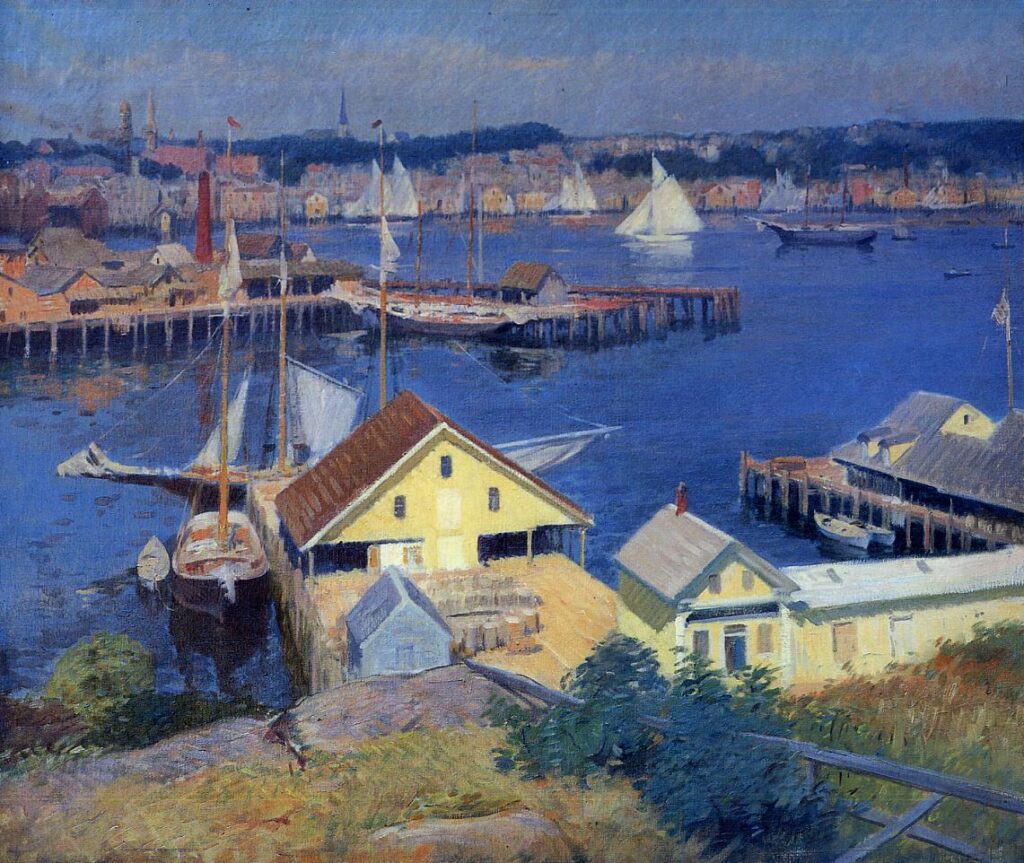Paintings of Gloucester Harbour: 1850-1910

This weekend I’d like you join me on a trip to one of the oldest artist’s colonies in America, and once one of it’s busiest ports, the city of Gloucester in Massachusetts, just over thirty miles (50 km) north-east of Boston. Its large natural harbour has been painted by a succession of many of the greatest American landscape artists since the middle of the nineteenth century, and my selection of their works in this weekend’s two articles is a potted history of modern painting styles.
United States Geological Survey, Map of Annisquam River (Massachusetts) and environs (1893), printed map, USGS 15 Minute Series, Gloucester, MA Quadrangle, 1893. Northwest corner. United States Geological Survey, US Department of the Interior. Wikimedia Commons.
This map of the Cape Ann peninsula from 1893 shows the areas that you’ll see pictured, around Gloucester Harbor that encloses Ten Pound Island to the south of the city, surrounding beaches, and as a finale to tomorrow’s article, the old abandoned settlement of Dogwood in the hills to the north.
Fitz Henry Lane (1804–1865), Gloucester Harbor (1850), oil on canvas, dimensions not known, Cape Ann Museum, Gloucester, MA. Image by Daderot, via Wikimedia Commons.
It was local artist Fitz Henry Lane who first started painting the coast here, in the first half of the nineteenth century. His early style steadily evolved through paintings like this of Gloucester Harbor from 1850 as he increasingly explored the effects of light and atmosphere.
Fitz Henry Lane (1804–1865), Ship in Fog, Gloucester Harbor (c 1860), oil on canvas, 61 x 99 cm, Princeton University Art Museum, Princetown, NJ. Wikimedia Commons.
By about 1860, when Lane painted Ship in Fog, Gloucester Harbor, this had reached Luminism, an approach allied with the writing of Ralph Waldo Emerson and the Transcendentalist movement.
In the summer of 1873, the aspiring Boston artist Winslow Homer visited, at a critical time in his career. He was in the process of making watercolour his preferred medium, and abandoning work as an illustrator, to devote his time to landscape painting.
Winslow Homer (1836-1910), Gloucester Harbour (1873), watercolour and gouache on paper, 24.1 x 34.3 cm, Private collection. Wikimedia Commons.
This matching pair of watercolour (above) and oil (below) versions of the same motif demonstrate his skill in both.
Winslow Homer (1836-1910), Gloucester Harbour (1873), oil on canvas, 39.37 x 56.83 cm, Nelson-Atkins Museum of Art, Kansas City, MO. Wikimedia Commons.
Perhaps as a result of his visit to France, many of Homer’s paintings during the 1870s showed very loose brushwork, and greater emphasis on markmaking than previously. At first the critics were disparaging of his watercolours, but they were popular and sold well. He also developed and often used a wide range of techniques to enhance his watercolours. These included the use of both transparent and opaque watercolour, thin layered washes, scraping, texture, resist, splattering, and even abrasive paper.
In the late 1870s Homer became more reclusive, lived in Gloucester, and at one time in Eastern Point Lighthouse, before he travelled to England, where he lived and painted in the coastal village of Cullercoats in 1881-82.
Willard Metcalf (1858–1925), Gloucester Harbour (1895), oil on canvas, 66.4 × 74.3 cm, Mead Art Museum, Amherst College, Amherst, MA. Wikimedia Commons.
Willard Metcalf, an American Impressionist who was born near Boston, visited and painted Gloucester Harbour in 1895. This is his view of Smith Cove in East Gloucester, looking towards its inner harbour, with the town itself on the opposite shore. It’s a superb set-piece of what had been a couple of decades earlier the busiest port in the USA. With the rapid decline of sail at the end of the nineteenth century, though, it was slowly returning to a quieter existence, with its supporting industries reducing.
Frederick Childe Hassam (1859-1935), Gloucester Inner Harbor (c 1899), oil on canvas, 61 x 50.8 cm, Dumbarton Oaks Research Library and Collection, Washington, DC. WikiArt.
In about 1899, Metcalf’s contemporary Frederick Childe Hassam, another American Impressionist, visited and painted Gloucester Inner Harbor. Hassam had also been born in Boston, and like Homer had been a successful illustrator before visiting Europe in 1883.
Frank Duveneck (1848–1919), Horizon at Gloucester (c 1905), oil on canvas, 61 × 91.4 cm, Cape Ann Museum, Gloucester, MA. Wikimedia Commons.
Frank Duveneck had been born in Kentucky and joined the German community in Cincinnati, Ohio, before studying alongside William Merritt Chase in Munich, Germany. When he returned to the USA, he found first success in Boston. Later in his career, he spent his summers in and around Gloucester, where he painted his Horizon at Gloucester (c 1905), showing the port’s distinctive skyline from Eastern Point.
Frank Duveneck (1848–1919), The Yellow Pier Shed (c 1910), oil on canvas, 30 x 36 cm, Private collection. The Athenaeum.
The Yellow Pier Shed (c 1910) is another of Duveneck’s summer paintings of Gloucester’s harbour.
Frank Duveneck (1848–1919), Brace’s Rock (c 1916), oil on canvas, dimensions not known, Private collection. The Athenaeum.
Curiously, in his final years he painted several views of Brace’s Rock (c 1916), off Eastern Point, Gloucester. Fitz Henry Lane had done the same shortly before his death.




